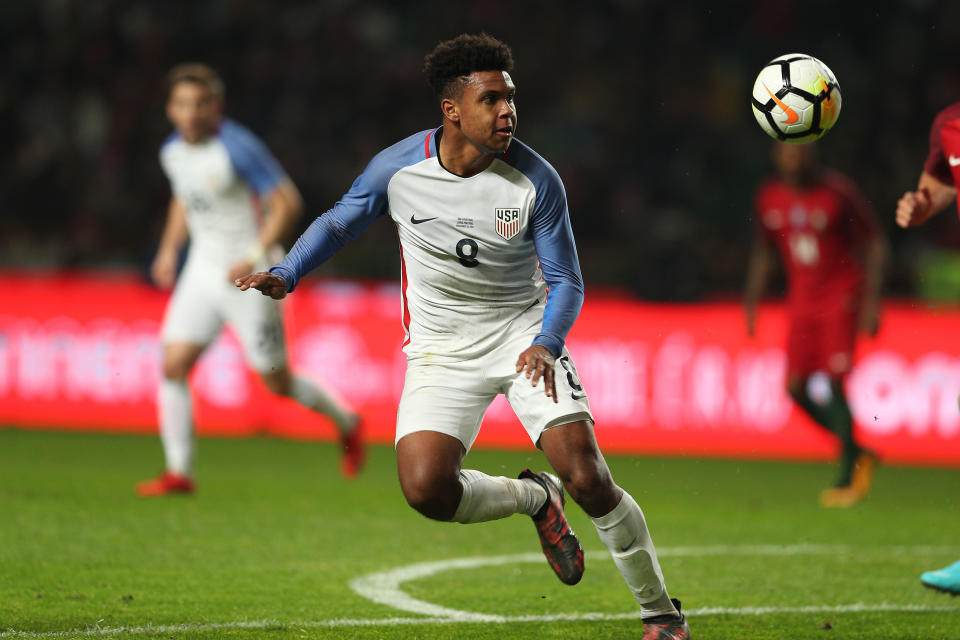A new USMNT generation of 'social butterflies' and 'clowns' is sprouting before our eyes
PHILADELPHIA — On the list of potential settings for an international soccer rebirth, the University of Pennsylvania is pretty far from the top. But it’s here, on a beautiful sun-drenched Monday morning, that the U.S. men’s national team’s next generation began to take shape.
As Dave Sarachan leaned up against a fence on one side of Rhodes Field, with roaring traffic and a rumbling freight train threatening to drown out his words, one couldn’t help but look over the interim manager’s shoulder, out onto the well-manicured pitch. There, in a seven-man warmup circle, were Weston McKennie, 19, fresh off a strong debut season at Bundesliga runner-up Schalke; Tim Weah, 18, fresh off his first Ligue 1 start at PSG; and Werder Bremen striker Josh Sargent, 18. There were Benfica’s Keaton Parks, Manchester United’s Matthew Olosunde and Everton’s Antonee Robinson, all 20; and erstwhile 2014 World Cup phenom Julian Green, 22.
And if you let your imagination wander, you could envision Christian Pulisic and Tyler Adams there alongside them. You could envision the future.
And whether or not that future was bright, it was bubbly and energetic. McKennie and Weah horsed around, playfully battling during a popular juggling game, as others laughed. The latter, at one point, found himself seated on the grass, a smile on his face, a finger – we won’t say which one – raised in McKennie’s direction.
For many of the 22 players called in by Sarachan for next Monday’s friendly against Bolivia, and especially for the 15 who haven’t yet celebrated a 23rd birthday, this week represents a first senior national team camp with one another. There are seven uncapped players, and 13 with two or fewer USMNT appearances. For some, the week will be a feeling-out process. Their days together will be the first building blocks of relationships that will hopefully last for years.
But as several players have pointed out over their first 48 hours together, many of those relationships have already been built.
“A lot of us know each other from the youth days,” says 22-year-old center back Matt Miazga. “We’re all comfortable with each other.” His defensive partner Cameron Carter-Vickers, striker Andrija Novakovich and McKennie made the same point.
And McKennie is even familiar with Parks, the only one who has never shared a national team training field with any of the other 21 players in Philly this week. The two played against each other as kids in north Dallas suburbs.

There are others who’ll be part of the rebuild who aren’t present. But they’re still connected to it. McKennie, who describes himself as a “social butterfly,” recently met up with DeAndre Yedlin and Bobby Wood on vacation. He joined Sargent, Erik Palmer-Brown, U.S. youth internationals Nick Taitague and Haji Wright, and others at Pulisic’s home in Germany for an all-American meet-up. He even had Thanksgiving dinner with Pulisic – who’ll likely join the national team late Thursday – two days before the pair sparred in a Revierderby, Germany’s fiercest rivalry.
The two live about 30 minutes from each other, and see each other once a week, if not more often. And they, in many ways, embody the rebuild. They’re the preeminent teenage talents. And they embody the burgeoning chemistry within the group, and the root source of it. By a stroke of luck, on their first bus rides during an 80-player youth national team camp, they sat next to each other. McKennie used to squirt an empty water bottle into 13-year-old Pulisic’s ear.
“He thought I was the most annoying kid,” McKennie says with a laugh.
Six years later, he still has that youthful exuberance, but also impressive maturity. It’s difficult to consider a 19-year-old a leader, but McKennie seems as close to one as can be. He’s one of the first to bound out of a huddle around Sarachan and into Tuesday’s first drill. He might as well have future national team captain written on his training top.
“I’m still young, I’m still learning,” he says. “At some point, do I feel like a leader? Yes, in some sort of way, toward the guys who are younger than me. But I also feel like I’m being led.”
He looks to his left, then continues. “Even this kid right here, Matt Miazga, he’s more experienced than me too. Even though he’s a clown, I respect what he says on the field.”
Miazga’s face explodes with a smile when informed of McKennie’s lighthearted jab minutes later. “He’s a clown!” Miazga says of McKennie. “He’s a clown!”
There are surely some who will balk at the thought of a U.S. men’s national team, in May of 2018, having fun. The World Cup will begin in less than a month without it. Penn is a long way from Russia. The thought still leaves a sour taste in the mouths of many.
But there’s no point in grieving. The future is here. Here, in Philly. Here, in that juggling circle. And in another one Tuesday, this time featuring Weah, Sargent, Olosunde and Palmer-Brown. Out of nowhere, Weah spins away from it and launches a 30-yard curler from closer to the left sideline than the penalty box. It skims in off the crossbar, a foot inside the far post. He wheels away in feigned celebration, first with airplane arms, then a few fist pumps, further stimulating our imaginations.
– – – – – – –
Henry Bushnell covers global soccer for Yahoo Sports. Have a tip? Question? Comment? Email him at henrydbushnell@gmail.com, or follow him on Twitter @HenryBushnell, and on Facebook.
More soccer from Yahoo Sports:
• 2018 World Cup preview hub
• What Christian Pulisic lost when the U.S. missed the World Cup
• FC Yahoo Mixer: Consequenes of USMNT’s World Cup absence
• How Putin can use the World Cup to his benefit



